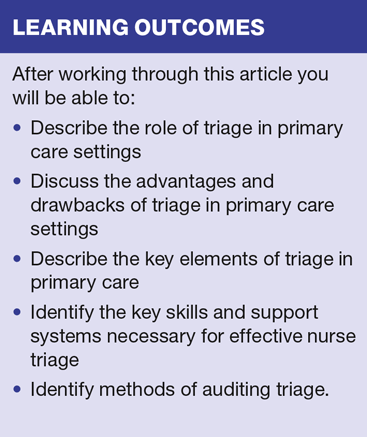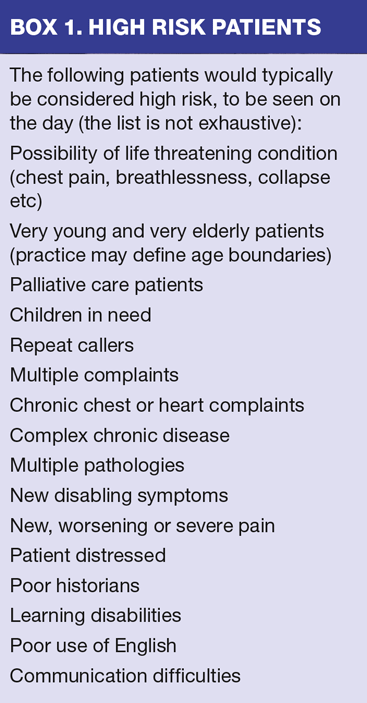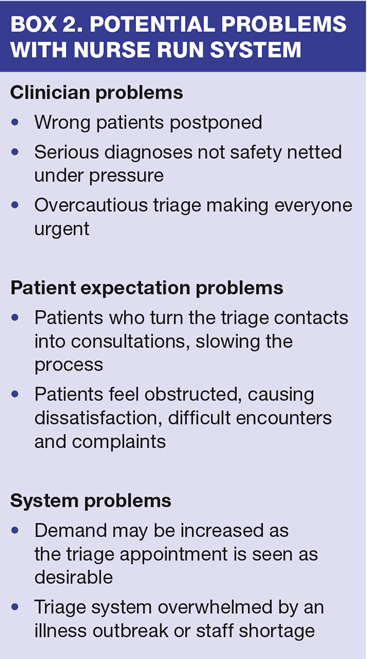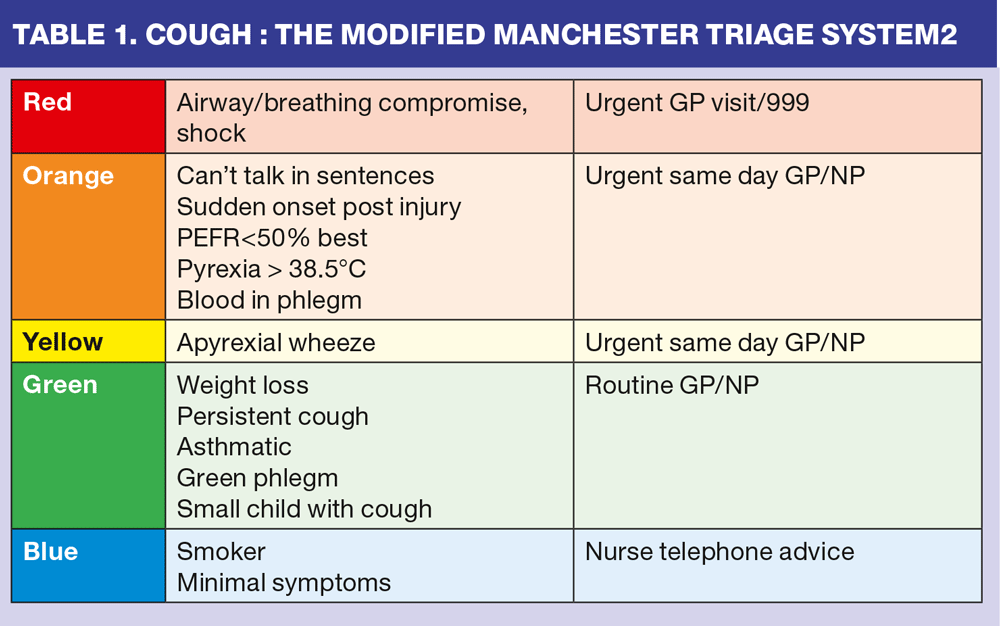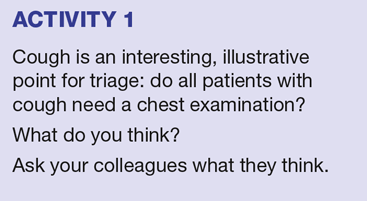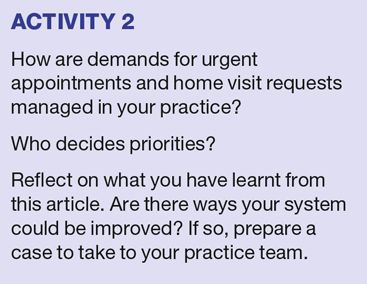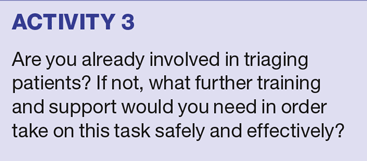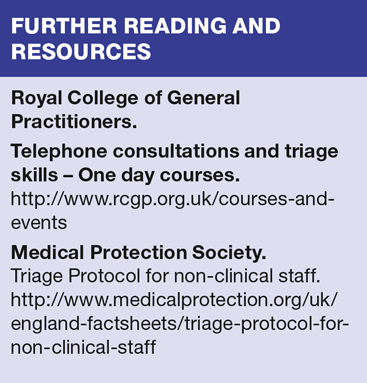Using triage to manage demand in practice
Dr Mary Lowth
Dr Mary Lowth
MA MB BChir FRCGP PGCMedE
GP and MRCGP examiner
As general practice struggles to meet unprecedented levels of demand, practice nurses are increasingly involved in triage. For nurses to become competent and confident, and patients triaged safely and effectively, specific training and the support of the practice team is essential
Practice nurses are increasingly asked to take part in the triage of patients, in order both to manage demand and to make sure patients are seen with appropriate urgency. Good triage can educate patients, improve efficiency and improve the quality of care the practice offers. However good triage needs skilled assessment, communication, risk management and good clinical skills. In this article we discuss triage, the ways in which it is offered in primary care and what you need to be a more competent and confident triage nurse.
WHAT IS TRIAGE?
The term triage has its origin in the Napoleonic wars, when it referred to management of casualties on the battlefield. It comes from the French verb ‘trier’, which means ‘to separate out’ and involves dividing the wounded into three groups:
1. Those who would die whatever care was offered
2. Those who would live whatever care was offered
3. Those for whom care would make a difference.
Then, as now, triage is a means of prioritising according to clinical need, in order to deliver the most effective care overall.
TRIAGE IN PRIMARY CARE
In primary care we don’t have to decide (under pressure) that patients are beyond help, nor are we operating under fire (even if we sometimes feel that we are). We do, however, employ a modified form of triage, ranking patients according to priority and need.
In primary care triage is typically used to:
- Manage urgent on-the-day demand
- Ration immediate and urgent appointments
- Manage home visit requests
- Distribute all appointment requests
- Manage telephone calls
- Spread non-acute workload forwards into quieter days, freeing clinical time on busier days
- Educate patients in appropriate use of the service.
Common to all the above is the idea that some patients need to be seen more quickly than others, and some may not need to be seen at all.
KEY SKILLS FOR EFFECTIVE TRIAGE
The key skills necessary for effective triage can be divided into four groups:
1. Assessment of the patient
Assessment for triage differs from the normal diagnostic process in that what you are aiming to do is assess and assign, not diagnose and treat. In order to do so you may form a view of the diagnosis, but this is not your primary task. Your task is to assess urgency and determine the appropriate pathway for that patient, bearing in mind the resources at your disposal and the likely needs of the other patients on your list that day.
You must decide:
- What is the presenting complaint?
- Am I competent to assess this patient?
- Based on my assessment, what is my level of clinical concern?
- Who should see this patient?
- How quickly does this patient need to be seen?
- Am I confident in my decision?
2. Background knowledge
In order to perform this assessment you need to have a clear picture of what your system can offer, and its capacity on any given day. You also need to have an idea of your expected demand; to have a mental picture regarding which ‘other’ patients the one in front of you must be ranked against.
3. Knowing your demand
Practices should take a moment to assess their current levels of demand, in order to make sure they are providing the right mix of appointment slots.
Many practices make a record of all requests for contact with a member of the practice team over a typical period of two or more weeks. This can give an indication of demand – but bear in mind that when capacity is increased demand will often increase as well, as the ‘effort cost’ of seeing us declines.
4. Protocols
The practice should have provided and agreed protocols to support your decision-making and ensure consistency and good practice. These should include lists of high-risk patients and high risk conditions that always justify ‘on-the-day’ appointments. (Box 1)
Protocols and algorithms should also be developed to help detect specific diagnoses in patients who would not otherwise be considered high risk, such as uncomplicated cough (see below and Table 1) The NICE guidance, ‘Feverish Illness in Children: Assessment and Initial Management in Children Younger Than Five Years’ is particularly helpful in the assessment of young children.1
EXAMPLE: WHAT TO DO WITH COUGH?
Cough is an interesting illustrative point for triage: do all patients with cough need a chest examination? A paper published in 2002 offered a possible triage system for cough in a primary care setting.2 Crucially this guidance was developed by a team (yours might be different) and, while not exhaustive, was felt to cover most common presentations. (Table 1)
Once you have separated out all those patients in high risk categories (Box 1) do all remaining coughs need to be examined? This point is raised as an exemplar to help with the feeling that nobody with symptoms ought really to wait.
- If trainers ask GP registrars if patients with a cough need a chest examination, most will initially answer yes.
- If you ask whether that is true of patients who look well, with normal respiratory rates then a few will say no.
- If you ask whether, when someone coughs on a bus beside them, they would suggest that person see a doctor, they would reply, it would depend how ill they look.
- If you ask if all patients with a cough should visit the doctor for examination, they start to ‘triage’ out some patients e.g. those who are otherwise fit and well and have a simple cough post- upper respiratory tract infection (URTI), do not need chest examination in order to alleviate clinician concern.
We can therefore conclude that not all patients with cough need to be seen today, and can further conclude that not all patients with cough require chest examination. Patients with a cough who look well (and who say no to a few protocol driven questions) are highly unlikely to have positive chest signs. Patients expect to have their chests examined, but does it need to be today and, indeed, does their chest need to be examined at all?
ETHICS OF TRIAGE
Deciding that some people are low priority can feel ethically uncomfortable when we are taught to give every patient the best care we can. The key to this statement lies in those last few words. Ethically, the case for triage is fairly straightforward. It sets best treatment for all against the needs and wants of individuals and finds a balance. In doing so it attempts to act in the group of patients’ overall best interests, given the limitations of what is available.
Primary care triage is needed because we cannot offer every patient exactly what they want, in terms of timing, length and urgency of appointments. Triage aims to allow you to offer the most effective overall care for all patients, based on their health needs.
UNDERLYING SUPPORT FOR NURSE TRIAGE
System support
In order to triage well nurses must be supported by sufficient appointment slots to meet the need. You can’t triage into nothing, nor can you work well and confidently if people are complaining that you are making them too busy. All members of the team need to own the system and play their part.
Adequate staffing
There need to be sufficient numbers in the triage team to assess patients without unacceptable waits. Having a long wait may increase patients’ demands to be seen fully.
Nursing skills
The clinical skills of an experienced practice nurse are highly transferable. Nevertheless triage requires specific training so that nurses can work both competently and confidently. At least some of this training should be ‘in house’ and should include review of difficult cases, debriefing after difficult days, significant event audit and outcome audit (see below).
Follow-up and record keeping
Good triage must be backed up by clear record keeping. Communication with patients also needs to be clear (and backed up by written information) so that they understand the outcome. This information also requires good safety-netting, so that they understand what kind of circumstances should make them return prior to their triaged appointment.
RESPONSIBILITY
It is vital that nurses always practise within their own limitations and competence. You are professionally accountable to the Nursing and Midwifery Council (NMC), as well as being contractually accountable to your employer.
INEFFECTIVE TRIAGE
If we don’t triage patients, someone else will do it by default. The service may then be less informed. Moreover the wrong patients may be seen first, and problems can follow.
Others who will triage if we don’t include:
The dragon receptionist
Once upon a time we had the dragon receptionist, who simply got more difficult the busier the doctor was. Often remembered wistfully by GPs who watched ‘Dr Findlay’s Casebook’, this triaged patients according to the doctor’s needs and the receptionist’s opinion, neither of which are a good way to go in the modern NHS.
The modern receptionist
In some practices, reception staff triage patients, asking them if their problem is urgent and asking for clinical information to enable prioritisation.
In the case of home visit requests, many practices still expect receptionists to ascertain the reason for the request and, in certain circumstances, to refuse it. Many receptionists feel this puts them in a precarious position, as they lack the clinical knowledge to underpin their decisions. It is one thing to try to negotiate patients into coming to the surgery and accepting an available appointment. However, without very clear protocols it seems unwise to ask non-medical personnel to take responsibility for actually refusing home visits or urgent care.
The patients
Where there is no formal triage then patients will self triage. The ones who are seen most urgently will be those making the most fuss, which may not always be medically justified.
Many practices ask patients to decide if their problem is urgent or not, and whether they feel it is OK to wait in line and be seen on the day. Often, when the patients are actually seen we do not feel that their problem merited an urgent appointment – but how can we expect patients to judge this? They lack knowledge of their relative urgency compared to all the other problems in the waiting room.
A system like this risks giving urgent slots to those who are prepared to demand them, while others with greater clinical need give up, because of the wait or through feeling that perhaps urgent is not the right word for their chest pain.
Sometimes people can win an on-the-day appointment only by telephoning at a specific time in the morning or by waiting in a queue at the door. This is selection by ability to use the phone or to turn up and wait, but it is not a measure of clinical need.
EDUCATING AND INFORMING PATIENTS
A successful triage system engages and informs patients as to why they are being triaged and to what purpose. Simply telling people they can’t be seen today because the doctors are too busy and they are not ill enough will not enhance patient satisfaction. Patients need to understand that a fair and effective system is in place. People are usually happy to queue if they feel it is fair and that ultimately you are helping them find the most appropriate appointment.
This kind of information belongs on the practice website, in practice leaflets and on information media in the waiting room. A handout for patients who are asked to come back on another day can be a useful addition.
AUDIT
Audit is a useful tool for judging whether triage is effective and well done. Possible methods include:
- Patient satisfaction surveys
- Clinician and reception staff opinions
- Monitoring of patient pathways of all patients over a specific time
- Spot review of random patients with another clinician
- Review of patients who attempted to engage and, following triage, were not seen
- Review of specific problems which have been flagged as significant events.
Inevitably, triage will not be perfect so when reviewing the care we have offered if can be useful to look for and classify the problems that may arise. (Box 2)
DEALING WITH COMPLAINTS
Practice nurses involved in face-to-face triage may find themselves on the receiving end of complaints. Patients complain for many reasons, not just because they don’t agree with you or would prefer to talk to a GP, so it’s important to try not to feel professionally defensive.
Patients complain because they:
- Have previously been used to a system of walking in and waiting to be seen
- Expect a higher priority than they are given
- Fear a serious illness
- Are time-poor and the method adds inconvenience
- Made an effort to come today
- Have found, through previous experience, that walking in is the best way to be seen
- Have waited a long time for triage
- Disagree with your clinical decision.
You may need to explain the system to them, perhaps with a printed sheet, a conversation and waiting room information. Disagreement with your clinical decision does happen, of course, and you need to be prepared to review your opinion. If it still stands you must explain why.
Protocols are helpful, but beware of using a ‘we do it this way’ explanation with patients. ‘We’ is a word that belongs in consultations only when it means you and the patient, not when it means you and other staff members. People don’t like to be told that they can’t have what they want or need because ‘that’s the rules’ and ‘we’ make the rules. You need to explain the situation to the patient in terms that sound fair to them. For instance: ‘I understand you are feeling unwell but the surgery has very few appointments left today and must keep them for people with medically urgent conditions. Your condition is important but it isn’t medically urgent, and it’s important to make space for urgent patients. The staff will offer you the earliest appointment they can, with a doctor who will give you time without being under that emergency clinic pressure.’
SUMMARY
In most practices demand for urgent or on-the-day appointments is now at a level that has to be managed actively, according to clinical need. It is not enough to leave the system to find its own level, so that only the more demanding patients are seen – to do this often disadvantages those who need us the most.
We must manage patient demand so that, on days when demand outstrips capacity, those with the greatest clinical need are seen in a timely fashion. Those who can be seen later can then be offered later appointments, together with an explanation and information. Staff will no longer feel irritated that non-urgent problems are being given urgent appointments and, possibly, patients will be educated in use of the system along the way.
This is not at all easy, and can involve a hard look at staffing levels in order to back up the system - but with good teamwork, clear protocols, focused training and clear audit it is possible to set up a system that benefits staff and patients alike.
REFERENCES
1. NICE. Feverish Illness in Children: Assessment and Initial Management in Children Younger Than Five Years CG47, 2007 http://publications.nice.org.uk/feverish-illness-in-children-assessment-and-initial-management-in-children-younger-than-5-years-cg47
2. Barron S. Modifying the ‘Manchester triage system’ in practice. Primary Health Care 2002;12(2): 37-39 http://primaryhealthcare.rcnpublishing.co.uk/archive/article-modifying-the-manchester-triage-system-in-practice
Related articles
View all Articles
